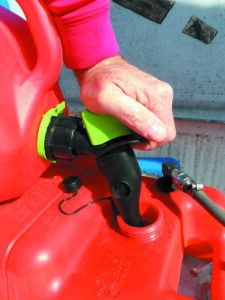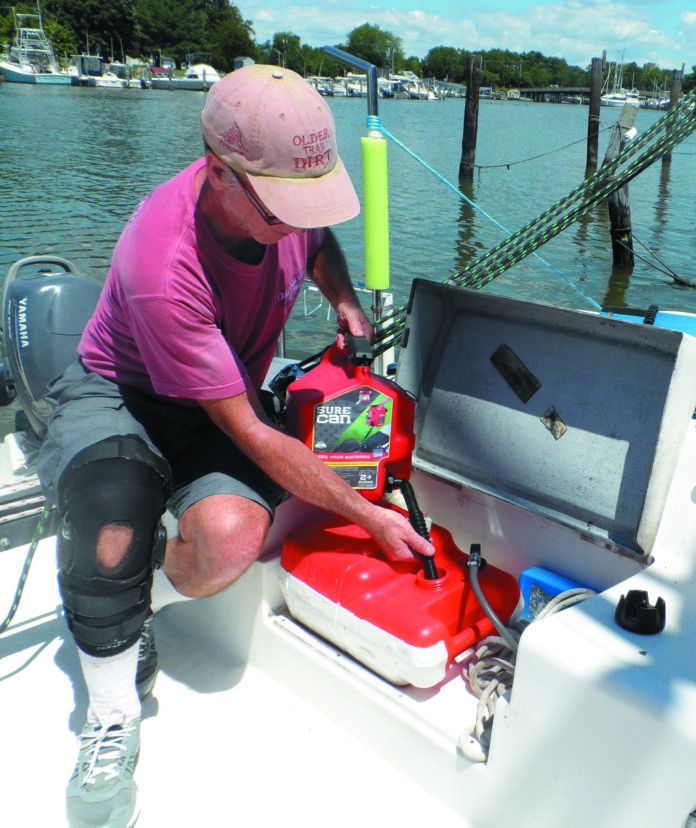Everyone hated the first generation of CARB gas cans. Intended to reduce volatile emissions by recovering vapors and reducing spills, they did exactly the opposite. The nozzles were cumbersome, hard to control, and fragile. Pouring was slow and spills increased dramatically. Many, like us, resorted to hoarding older non-CARB cans with user-friendly spouts, collecting them from yard sales if need be.
For five-gallon cans, we still like a simple jerry can and a shaker siphon (see PS November 2016, “Taking the Spill Out of Fill-Ups”). If you can rest the can on something above the fill cap level (the boat’s cabin top, for example), the shaker siphon does the rest. However, using a siphon requires an older jerry can. Using a siphon with a newer can requires removing the flame mitigation device (flame arrestor) from the fill opening. The first generation CARB spouts can often be replaced with plain caps, available through Amazon.
The two new models we have been testing for the past few years have turned out to be better than the pre-CARB cans in a number of important ways. When transporting to the boat, the stink in your car is much less, the result of low-permeation plastics. The odor while pouring is also less because the vapors are sucked back into the can.
Pouring rates in the new cans are nearly as fast as pre-CARB cans. Best of all, the makers of the new cans finally got the valves right. Instead of an awkward arrangement that had to be pressed against the filler to open, they are activated by the grip, allowing precise metering of gasoline.
We haven’t experienced an overfill or significant spill since we started using these cans, and that is something we could never say before, not with the best pre-CARB can. Because the cans are not vented until the valve is opened, you must be certain to place the nozzle in the filler before opening the valve. There can be a small puff of air or gas until the vent equalizes the pressure.
Note that we tested only the smaller cans, suitable for filling dinghy outboards, portable fuel tanks, and lawn care equipment. We still use shaker siphons with our 5-gallon cans.
SURECAN (GENERATION 2)
We used this can for precision filling small bottles with gasoline and diesel fuel for corrosion testing, seldom missing our 500 ml fill target by more than 5 ml. Amazing for a portable can. It does not have a flame mitigation device on the discharge spout; it is exempt from this requirement because the discharge is from the bottom of the can, below the liquid level.
To discharge gas, a cap is removed from the spout, which is rotated down into the tank filler. The trigger is pulled (safety lock under one finger), which simultaneously opens a vent under the handle and opens the discharge. When finished, release the handle, rotate the spout up, and replace the cap.
Bottom line: Listed at $45 for a 2.2-gallon jug this smart design is our Best Choice for filling small tanks. Be sure to specify Generation 2 when purchasing.
SCEPTER SMART CONTROL
We thought the flame mitigation device on this can (see below) might slow filling at the gas station pump, and by extension, the discharge rate, but it has no effect. The valve is not quite as precise as the Surecan and can occasionally stick just a bit, but it never caused a spill. To discharge gas, place the spout in the filler, flip the dark green tab up, then press the large lighter green button in with the palm of your hand. This opens the vent and opens the valve. When finished, release the large button.

Bottom line: At $27, a two-gallon jerry can is cheaper than the Sure Can and does the job, rating as a Budget Buy.
CONCLUSIONS
The new cans from Scepter and Surecan have been a pleasure to use. We like 1-liter aluminum fuel bottles for alcohol stoves and emergency fuel for the dinghy.
Flammable liquids are inherently hazardous, but their familiarity makes this characteristic too easy to overlook. But we can live safely with gasoline if we understand the rules and put some engineering controls in place to help us when we goof.
Only use containers rated for flammable liquids, which includes requirements for sturdiness and static conductivity. Use safe filling practices, which include understanding all possible ignition sources and considering where the vapors will go.
Want to carry a liter of backup gasoline for your tiny outboard with an integral tank? The MSR fuel bottle— used by backpackers for decades—is a smart way to carry a spare fuel in the dinghy. Gasoline will keep for at least six months if tightly sealed in a metal container. For more on storing gas, see PS December 2019, “Gasoline Additives in the E-15 Era”).
Dispensing a flammable liquid in the presence of an ignition source—a flame or even a spark—can cause a flash fire which can extend into the can. Pressure builds inside the can, and which either ruptures or jets fuel from the opening. Obviously, you should make every effort to eliminate ignition sources (turn the engine off, no cell phones, not smoking), but mistakes happen. Never point a gasoline or alcohol can at someone while pouring, in case the fuel jets.
On December 21, 2020, Congress passed The Portable Fuel Container Safety Act of 2019 (H.R. 806/S.1640) with bipartisan support, and it was soon signed into law. The Consumer Product Safety Commission was directed to adopt a standard requiring the addition of flame mitigation devices (FMDs) to consumer-grade portable, non-disposable fuel containers. Standard ASTM F3326 details the requirements, which some makers have already begun to implement.
There is also work being done on disposable containers, such as solvent and alcohol fuel cans. ASTM F15.72 task group began their work in 2018 but are far from finished. Health Canada now requires that alcohol fuel be sold only in containers fitted with “a functional flame mitigation device for the useful life of the product.” They have also banned the sale of many alcohol fireplace products because of injuries due to flame jetting. Several alcohol fuel vendors, including Nu-Flame and Smart Fuel, include flame mitigation devices in each fuel bottle.







































